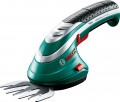Attachments
-
For bushes. An attachment designed for cutting thin branches, typical of most shrubs. The general principle of operation of such a device is similar to hair clippers: there are two sets of teeth located close to each other, one of them is stationary, and the second moves back and forth at high speed during operation. As a result, each pair of movable and fixed teeth works like scissors, cutting leaves and branches that fall under the blades. The nozzle itself looks like a blade stretched forward, with teeth on both sides of it; this allows you to move it in any direction during work - to the right or left, depending on the situation. It is worth noting that bush attachments are capable of coping with branches up to 2-3 cm (depending on engine power), however, they are still not designed for use as full-fledged saw.
-
For grass. Attachments designed for cutting grass and leaves. Like bush ones (see above), they use two rows of teeth; and in general, a hedge trimmer with such an attachment is similar to an enlarged clipper, only not for hair, but for grass. It is worth noting that it is not capable of replacing a full-fledged lawn mower: the cutting width most often does not exceed 20 cm, and the devices themselves are usually small battery-powered models (see “Power”) and are not designed to work with large areas. Their main purpose is the decorative treatment of small flower beds, as well as edges
...that a regular lawn mower cannot reach.
— Saw blade. Such attachments are very similar to the working element of a chain saw: an elongated rounded base (bar), along the edge of which cutting teeth move during operation. They are designed for cutting thick branches that conventional bush attachments cannot handle (see above), and are used primarily in pole pruners (see “Type”).Pole length
The length of the bar usually refers to the total length of the brush attachment or saw blade (see Attachments) supplied with the hedge trimmer. The
longer the tire, the longer the cut that the tool can make at a time. In general, it is believed that a short length is typical for entry-level tools, while professional ones are equipped with larger attachments. However, here you need to take into account that the choice depends not only on the scale, but also on the specifics of the intended work: long attachments are less maneuverable and less suitable for topiary trimming of bushes. In addition, the cost of a brush cutter also largely depends on this parameter.
Battery voltage
Operating voltage of the battery in a battery-powered hedge trimmer (see above). This parameter is usually selected by the manufacturer according to the characteristics of the engine: the greater the power, the greater, the battery voltage is likely to be. In fact, voltage data may be needed only if the battery fails and it will be necessary to replace it with an equivalent one. In addition, there are formulas that allow you to roughly estimate the battery life depending on the battery voltage, its capacity and the power of the tool; they can be found in special sources.
Capacity
The capacity
of the battery that comes standard with the battery-powered hedge trimmer (see above). Expressed in amp-hours, one ampere-hour means that the battery is capable of delivering 1 amp for 1 hour.
Last but not least, the battery life of the tool depends on the capacity of the battery. However, it is impossible to directly evaluate the battery life of a brush cutter by this parameter: the fact is that it depends on a number of other factors, ranging from engine power and battery operating voltage to the degree of complexity of work and contamination of the nozzle. Therefore, it makes sense to compare different models with each other in terms of battery capacity only if they do not have significant differences in other characteristics. But at the same time,
brush cutters with a capacious battery a priori allow the device to work more.
Noise level
Approximate noise level produced by the hedge trimmer in normal operation. This parameter allows you to evaluate how comfortable it will be to work with the tool: the lower the noise level, the less discomfort it causes for the operator and others, and the lower the likelihood that special hearing protection will be needed during operation. At the same time, note that loud noise is an inevitable side effect of high power — it would be too expensive and difficult to make a powerful and low-noise tool. In addition, this figure is only approximate. Firstly, different manufacturers may indicate it differently: for idling, for full speed, for half power, etc. Secondly, the actual volume of work may also differ from the claimed one due to the peculiarities of a particular situation: for example, working with thick branches leads to an increase in the load on the engine, which can also affect the noise level.
Another specific point is that the decibel used to measure this indicator is a non-linear value: an increase of 1 dB corresponds to an increase of 1.26 times, 3 dB — 2 times, etc. Therefore, to assess the loudness of work, it is easiest to use comparative tables. Here is one of the simplified versions of such a table for the range in which most modern hedge trimmers work:
65 dB — loud conversation at a distance of a metre;
70 dB — loud conversation of several people at the same distance;
75 dB — shout from the same distance;
80 dB — the ringin...g of a mechanical alarm clock, a loud cry at a distance of 1 m;
85 dB — loud screams at a distance of 1 m;
90 dB — heavy truck or freight car at a distance of 7 m;
95 dB — subway car at a distance of 7 m;
100 dB — noisy industrial shop.

